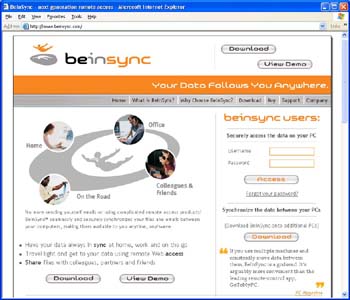Whether you’re at working at home on a deadline-driven project or at a sales meeting 1500 miles from the office, it’s a horrible feeling to suddenly realize you have the wrong version of your PowerPoint presentation. We’ve all been there, knowing that the version we need isn’t on the computer at our fingertips — and wishing we could get our hands on it — now. BeInSync makes that wish come true.
BeInSync — a peer-to-peer (P2P) file-sharing program — lets you set up your own secure P2P network between up to three of your computers. Once you’ve established your network, you can designate which files and folders you want to be visible on every computer in your network. From then on, BeInSync is responsible for making sure the latest version of each file and folder is always present on every computer.
The Problem
So what’s the big deal? After all, you can do the same thing with a Zip drive, which doesn’t require the $5.95 per month that BeInSync will start charging next month. The big deal is the fact that BeInSync synchronizes your files in the background, without the need of any input from you.
Data synchronization is one of the biggest problems I see on a daily basis. I provide tech support for faculty members at a liberal arts college, and I spend a lot of time on data security and integrity. The former isn’t a problem: Most people have taken to heart the lesson that their data isn’t really safe unless it exists in two places at once.
Few people, however, are aware that too many unsynchronized copies of a file can be as debilitating as too few. Which is the latest version? What do you do when you’ve modified a file at work and made other, different modifications to the file at home? Out-of-sync data can be as bad as no data at all.
BeInSync solves both data security and data integrity issues. You don’t have to worry about a hard disk crash because your data exists in two (or more) places at once. And data integrity isn’t a problem because your data is synchronized automatically, in the background.
Getting Started
You download the 9MB BeInSync installer. During the setup on your first computer you’re instructed to choose a username and password. When setting up subsequent computers, you will supply these same credentials. The most important step during the process is designating what files and folders you want to share across your P2P network. In addition to the default BeInSync folder, you can share My Documents, your Desktop folder, your local e-mail, and your Favorites folder. As I went through the set up procedure, I elected to share my Desktop folder, which is where I store my current work files. Turns out, my first step was a misstep.
When I setup BeInSync on a second computer, it began synchronizing the Desktop folders of the two computers, and I began to appreciate the power of the program and the danger of not thinking through exactly what you want out of it. As I watched, data files and folders from my first computer began appearing in front of me, along with installer files and other downloads that I didn’t want or need on the second computer. A later check of my Desktop folder showed that it was over 200MB, though only about 6MB were current work files that I wanted in both locations.

|
|
BeInSync software can keep your data synchronized on up to three computers at a time. |
Even over a broadband connection, the initial synchronization of 200MB (in effect, a straight copy) takes a long time. I quickly cancelled the sync and gave a little thought to what I was doing. In the end, I chose to share the default BeInSync folder. Using the Explorer-like interface, I dropped my current work files into the folder on computer number one, and watched as the synchronization icons next to each file quickly changed from red to blue, indicating that they’d been copied to computer number two.
In addition to letting you share files between computers you own, BeInSync gives you Web access to your files from any computer in the world. As long as one of your computers is logged into the BeInSync service, you can log onto the service with any browser from anywhere and access (i.e., download) your files. Not only that, but BeInSync lets you establish up to 10 shares on your computer that you can use to collaborate with other BeInSync users.
What’s Not to Like
The more data you want to synchronize, of course, the longer the initial file copying takes. Be judicious in what you share. BeInSync isn’t a replacement for a complete backup system; its strengths are file synchronization and remote access. And who wants to backup over an Internet connection anyway?
You also might appreciate the sharing of e-mail and Favorites more than I did. In a world of IMAP, MAPI, and Web-accessible e-mail, I don’t see a big need for synchronizing local mail folders. And frankly, since the advent of Google, who bothers with Favorites anymore?
If you need your data in multiple places and don’t want to have to think about how that happens, BeInSync is for you. It takes the pain and strain out of keeping your data in sync.
Bob Ryan works in IT in higher education. He has been writing about technology for over 20 years, including editorial stints at inCider, BYTE, and FamilyPC.
| Do you have a comment or question about this article or other small business topics in general? Speak out in the SmallBusinessComputing.com Forums. Join the discussion today! |

